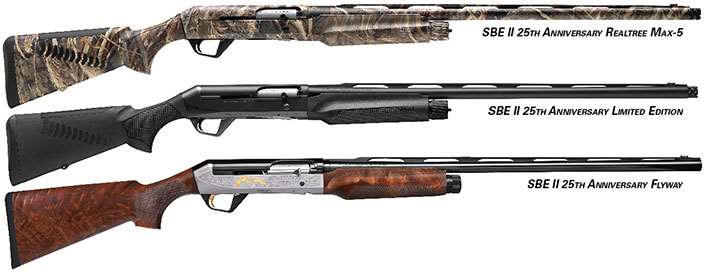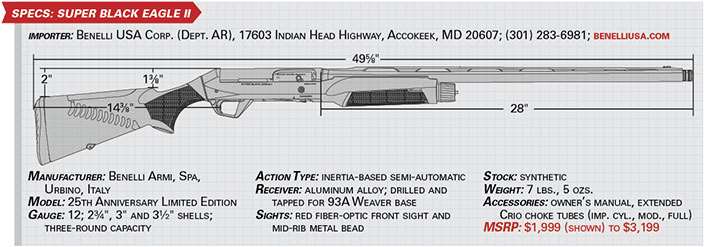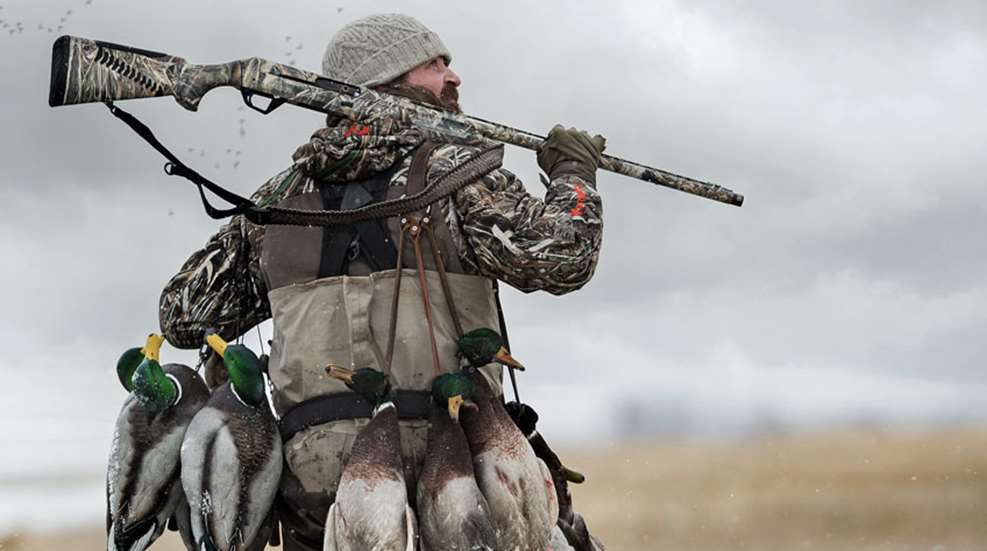
Unfailing operation in adverse conditions helped cement the reputation of Benelli's Inertia Drive system, as used in the Super Black Eagle, among a new generation of hardcore waterfowlers who had previously expected such reliability only from pump-actions.
The year was 1992, and though I was not yet of age to purchase a firearm, I remember the trip to Outdoor America as only a kid can. I stared at the small TV on the counter while a salesman paused the VHS tape and pointed to its lower corner. “See there?” he asked dramatically. “The fifth shell is fully out of the gun before the first one touches the ground.”
“Whoa,” I mouthed.
From the far side of the glass cases I memorized the all-matte-black gun’s specs. Whether or not it was the fastest-cycling semi-automatic on the market as it was touted—or even whether fast cycling was important for hunters—mattered little. Someday, somehow, the gun would be mine.
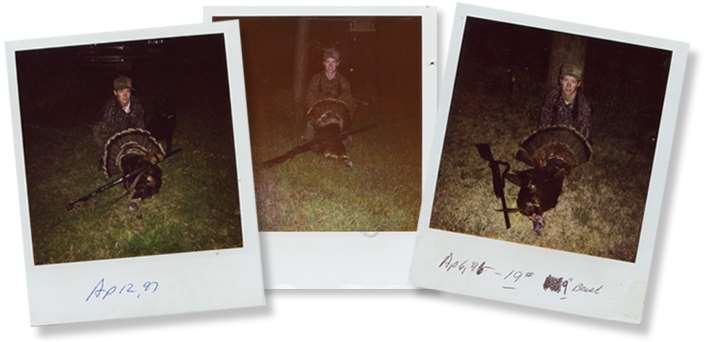
At the time, and for about a decade thereafter, Benelli’s cutting-edge Super Black Eagle (SBE) was the first and only semi-automatic shotgun capable of firing 2 3/4", 3" and behemoth 3½" shells interchangeably, without adjustment. The synthetic-stocked, inertia-operated gun—something not widely understood then—weighed just over 7 lbs., came with five choke tubes, sling swivels, a fiber-optic front sight with mid-bead, an interesting magazine release switch and an eye-popping price tag to boot. Even before I’d left the store with my father, I began a coordinated lobbying effort.
The crux of my campaign was that the Super Black Eagle would be the only shotgun I’d ever need. One gun for birds (it was light enough for quail and doves), deer (with slugs), turkeys (3½"), waterfowl, clay pigeons and anything else that needed plugging. So despite its then-high price tag of $1,000 for a plastic-stocked autoloader (at the time a perfectly suitable Remington 11-87 cost several hundred less) it would actually be cheaper in the long run for my dad. That was the straight-faced pitch, at any rate. Then he asked me what “inertia action” meant.
Sure, I heard the salesman parrot “inertia action” this and advantages that, but what was it, exactly? These days it’s assumed that the vast majority of Rifleman readers know exactly what “inertia-driven”—the company’s tag line—means. But back then it was an enigma. I told dad I’d get back with him on that soon.
Paolo Benelli is credited with Benelli’s spin on the inertia-action system in the ’80s and was granted U.S. patent No. 4,604,942 in 1986. The concept was an advancement from the Swedish Sjögren shotgun first made in 1908, which had failed to garner popular appeal.
In essence, it works like this: Upon firing, the bolt body, which is separated from its rotating head by a stout inertia spring, momentarily “floats” as the rest of the gun (barrel, receiver and stock) recoils rearward around it, compressing the spring. After the shell’s payload clears the barrel and gas pressures subside, the spring relaxes, propelling the bolt body rearward. A cam slot in the bolt body acts against a cross pin in the bolt head, rotating it out of engagement with the barrel extension. As the entire bolt assembly continues rearward, the extractor pulls the spent hull from the chamber and a sliding, spring-loaded ejector on the inside wall of the receiver abuts it on the opposite side, sending it out the ejection port. All the while, the rearward-traveling bolt continues to compress a recoil spring hidden in the buttstock. Once that spring bottoms out, it returns the bolt assembly forward on raceways toward the chamber, along the way picking up another shell from the carrier and shoving it into battery. The whole process happens in a fraction of a second.

The system’s genius is that it requires no gas port to foul like a gas gun, has no moving barrel like a long-recoil action and has fewer moving parts to wear and break than either. Gas and grime from the shell are mostly blown forward out of the barrel rather than siphoned back through ports and into the action as in gas-operated guns. As a result—as I explained to my father by stressing the forthcoming point—it’s incredibly reliable and it’ll shoot any shell.
So I was a little disappointed, frankly, when it was not found under the evergreen the following winter. But then I discovered something akin to a boat anchor in the bottom of my stocking, and quickly gleaned that it was a giant box of 3½" shells. Then my father produced another wrapped box. Thanks to good grades and an old man who viewed guns as more of an investment than an expense, I tore open the paper on that Christmas Day in 1992 and soon held my new shotgun high in my hands. I believe I heard Italian angels singing. Then, of course, I did exactly what anyone would; I grabbed the box of shells, stuffed my feet into the boots closest to the door and marched outside, glowing with bliss enough to melt the Oklahoma snow.
While sitting on my rear end with my knees pulled up in typical turkey-hunting form, I aimed at a Coca-Cola can 25 steps away. When I pulled the trigger, recoil rolled all 85 pounds of me backward so thoroughly that I can remember seeing my feet, the barrel and white fluffy clouds all in the same frame before I teetered back to my sitting position. The can was 10 yds. further back from where I’d shot it; a minnow bucket would have held more water. “Awesome!” I whooped.
From then forward I shot the mighty 3½" shell any time I had them. When I was 16 years old, I killed a turkey at—I hate to admit it—66 yds. I had no idea the bird was that far, until I stepped it off later. To this day the gun’s factory full choke patterns a Federal Premium 3½", 2¼-oz. No. 6 like a gray fog of death. The shell’s power, both downrange and behind the gun, remains purely awesome. Anyone who says the 3½" shell, with its giant payload, is a gimmick is either afraid of its recoil or incompetent in mathematics.
Energy produced by shotshells is academic. If all else is equal, the more buffered lead that is thrown downrange, the deadlier the load. For waterfowl, where steel reigns, I believe a heavy payload sent at high velocity offers greater advantage to the hunter. Whether those extra pellets are “needed” is like asking if a .300 Win. Mag. is needed if a rifleman already has a 30-’06 Sprg. Of course it is!
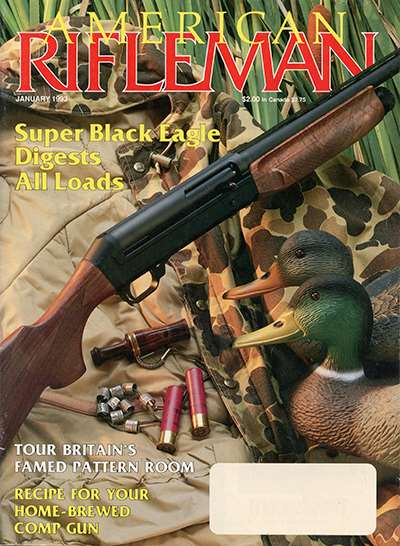
The Super Black Eagle gave shooters a magnum option with its 3½" chamber, and all but rendered the 3½", 10-ga. shell and guns that shot it obsolete. As such, for more than a decade it was the only shotgun that could truly do it all. It proved extremely reliable with all but the lightest 1-oz. target loads. While using hunting loads and standard 11⁄8-oz. target loads, my SBE has never failed me.
Meanwhile, elsewhere in America, the new shotgun was creating a buzz among hardcore waterfowlers. Soon, the Italians realized their appeal to Americans’ sense of “bigger is better” was working. The Super Black Eagle was actually essentially a lengthened version of the Black Eagle, a 3"-chambered semi-automatic with the inertia action that appeared in the mid-’80s. It didn’t take them long to see that the inertia action regulated itself using the natural recoil of the gun, and so they’d just need to lengthen the ejection port and recoil spring, which meant lengthening the action—hence the original SBE’s limousine-like 9" receiver—and modify the ejector rod to slide according to various size shells before forcing them out the ejection port.
The Super Black Eagle worked as advertised, and frankly it was priced such that many waterfowlers chose not to buy it—but I dare say most of them wanted it—and probably eventually bought it. Stateside Santas were certainly buying enough of them that Benelli saw the writing on the wall. At first, Benellis were imported by Heckler & Koch in Virginia, then Benelli USA opened its doors in Accokeek, Md. Benelli hired Americans such as Steve Otway and later Steve McKelvain to market it to American hunters. By 2005 it’s speculated that Benelli owned more than half of the waterfowl shotgun market.
“Whereas in the past most aspiring shotgunners yearned for a nice over-under, now they wanted a Super Black Eagle,” said McKelvain. “And it was a gun that lived up to the hype; it was the most advanced shotgun on the market … and still is.”
By the time of this writing, the SBE remains one of the few guns that can do it all, although it now accomplishes the task with more style and with less punishment to the shooter than before.
You see, the inertia action does have one downside: Recoil mitigation is not as pronounced as with a traditional gas system. Certainly the spring in the buttstock lessens some felt recoil, but recoil from a 3½", 2¼-oz. payload shotshell, when fired from a 7-lb., 8-oz. gun, totals roughly 65 ft.-lbs. of recoil energy—the equivalent of a .416 Rigby elephant rifle. While the Benelli’s punch is much less potent feeling than that of a fixed-breech gun, you’ll still feel it, to be sure.
Recognizing that, and still riding a hefty wave of momentum, Italian engineers at Benelli, which has been owned by Beretta since 2000, incorporated aesthetic design input from Benelli USA’s American staff to produce an easier-recoiling gun—albeit while updating styling along with hunter-friendly features and heft. What it ultimately did was tighten Benelli’s stranglehold on the American waterfowl market when, in 2006, the Super Black Eagle II hit gun racks.
Most notably, the SBE II differed from the original in its enlarged, angular trigger guard, a cryogenically-treated barrel that Benelli claims enhances patterns (this is very hard to prove), modernized lines and, most importantly, ComforTech stock technology that softens the blow of recoil on the cheek and shoulder while elongating the recoil impulse so that it is perceived as softer, too. Oh yeah, and it came with an enhanced price tag of around $2,000. Lucky for Santa, I’d already moved out.
Indeed, my original SBE accompanied me to college where I stashed it in my dorm room so I could hunt on weekends, and it’s spent many a cold night behind the seat of my truck.
Once, in early January, I was hunting ducks out of an aluminum jon boat situated on a grassy bank of a small island. Errantly I’d leaned my SBE on the outside of the boat for a few minutes while my Lab retrieved several birds from the ice-crusted water. When the dog jumped back into the boat, however, it knocked the shotgun over, fully submersing it. About that time, a flight of teal bombed the decoys, so I quickly fished the gun from the muck and fired as the birds foolishly made a second pass. I downed two greenwings before noticing that my face and chest were covered in mud that had been slung off the gun’s action when I fired. My buddies laughed. I then opened the action and noticed it was quite clean. It ran flawlessly for the rest of the day and indeed the season. I adore my Remington 1100, but it would not have fired a second shell.
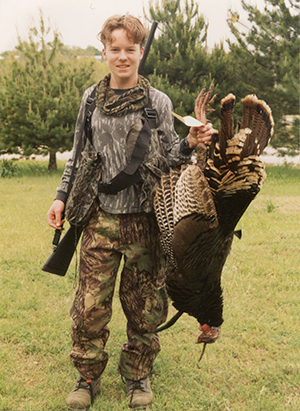 Ten years later, I was among a group of writers that took a pile of Benellis to Argentina. Ten men fired 1,000-plus shells per day for five days straight, and malfunctions could be counted on one hand. And everywhere I hunt, in-the-know hunters ogle it.
Ten years later, I was among a group of writers that took a pile of Benellis to Argentina. Ten men fired 1,000-plus shells per day for five days straight, and malfunctions could be counted on one hand. And everywhere I hunt, in-the-know hunters ogle it.
“Is that one of the original SBEs?” said one of my buddy’s buddies during a lull in the action one cold November morning. It was the first time I’d hunted with this cat.
“Yep,” I said. “See the H&K stamp?”
“Yeah, man. You can put an extra shell on the carrier,” he said. “And I just love the way those old ones point.”
“I’m not sure why you would willingly break a game law,” I said, “but you can remove your evil eyes from my Benelli.”
In 2006, after Paolo Benelli’s patent expired, several major companies were quick to jump on the inertia bandwagon. Browning now offers its iconic A5, only it’s been updated with its Kinematic Drive Action, which is just another name for inertia action. It’s a great gun. Weatherby and now Stevens also launched inertia-action guns, but they do not chamber the mighty 3 1/2". Regardless, these guns are a testament to the action’s effectiveness. Fact is, all great designs are ultimately emulated, and in the Super Black Eagle’s case, coveted.
Twenty-five years later, the Super Black Eagle legacy is still going strong, and in many waterfowling circles, it’s still the gun. To celebrate the one-gun-for-all’s success, for 2017 Benelli is releasing its Super Black Eagle 25th Anniversary Limited Edition model.
It includes a few enhanced features that sportsmen generally want but that were formerly only available from the custom shop for an added cost. In addition to standard, significant features like its ComforTech stock and shim kit that tailors stock fit to the shooter, upgrades include a brushed-nickel bolt that resists corrosion and an oversized bolt handle and bolt release. Being a hunter and an occasional three-gun shooter, I believe the oversized controls are helpful while wearing gloves or while under stress. It comes with three choke tubes—why not five?—a pre-drilled-and-tapped receiver for scope mounting and, of course, a 10-year warranty. If I didn’t have an SBE already, this is the one-and-done shotgun I’d buy.
Indeed, since that Christmas Day in ’92, my Super Black Eagle has been a steady companion at home, on the road and in the field. Here’s to 25 more.
